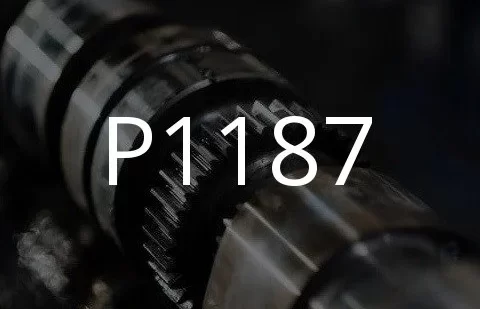
P1187 (Volkswagen, Audi, Skoda, Seat) Linear lambda probe, compensation resistor - open circuit
Content
P1187 – OBD-II Trouble Code Technical Description
Trouble code P1187 indicates a problem with the linear oxygen sensor, namely an open circuit in the compensation resistor circuit in Volkswagen, Audi, Skoda, Seat cars.
What does the fault code mean P1187?
Trouble code P1187 indicates a problem with the linear oxygen sensor in the vehicle system. Specifically, it indicates an open circuit in the compensation resistor circuit. The compensating resistor is a part of the circuit that is used to correct the signal coming from the oxygen sensor to provide accurate measurements of the oxygen content of the exhaust gases. An open in this circuit can result in incorrect or unreliable data being sent to the engine control unit, which can cause engine malfunction, poor fuel economy, and increased emissions.

Possible reasons
Several possible reasons why trouble code P1187 may occur:
- Broken wire or damaged connection: The wiring connecting the compensation resistor to the motor control unit may be broken or damaged.
- Damage to compensation resistor: The compensation resistor itself may be damaged, resulting in an open circuit.
- Corrosion or oxidation of connections: Corrosion or oxidation on wire pins or connectors can cause poor contact or open circuits.
- Malfunction of the engine control unit (ECU): A malfunction in the engine control unit, which is responsible for processing data from the linear oxygen sensor and compensation resistor, can also cause this fault code to appear.
- Mechanical damage to the sensor or its mountings: If the oxygen sensor or its mountings are damaged, this may also cause an open circuit in the compensating resistor.
To accurately diagnose and fix the problem, it is recommended to contact specialists at a car service center who will be able to carry out the necessary checks and repairs.
What are the symptoms of a fault code? P1187?
Symptoms that may occur with DTC P1187 may include the following:
- Unstable engine performance: If there is a break in the compensation resistor circuit, control of the fuel-air mixture may be impaired, which may lead to unstable engine operation. This may manifest itself in the form of chaotic operation, tripping, or rough idling of the engine.
- Increased fuel consumption: Improper management of the fuel/air mixture can result in increased fuel consumption. This may be due to the engine running inefficiently due to an incorrect signal from the oxygen sensor.
- Loss of engine power: Impaired mixture function can also lead to a drop in engine power. The car may respond more slowly to the gas pedal and have limited driving dynamics.
- Frequent engine stops or misfires: If there are serious problems with managing the fuel-air mixture, the engine may stop frequently or experience misfires.
- Engine Error or Check Engine: A check engine light or check engine light on your dashboard may be a sign of a problem, including trouble code P1187.
These symptoms can occur to varying degrees and in different situations, and may be caused by other problems, so it is recommended to carry out a diagnosis to determine the exact cause.
How to diagnose a fault code P1187?
The following steps are recommended to diagnose DTC P1187:
- Scanning error codes: Using a diagnostic scanner, read the error codes from the engine control unit memory. If a P1187 code is detected, it may indicate a problem with the linear oxygen sensor compensating resistor.
- Checking wiring and connections: Visually inspect the wiring and connectors connecting the compensation resistor to the engine control unit. Check them for damage, corrosion or oxidation. If necessary, perform a thorough check with a multimeter for breaks or incorrect connections.
- Checking the compensation resistor: Using a multimeter, check the resistance of the compensation resistor. Compare your values to the manufacturer's recommended specifications. If the values are not correct, the compensating resistor may need to be replaced.
- Diagnostics of a linear oxygen sensor: Carry out additional diagnostics on the linear oxygen sensor, as the problem may be related to it. Check its operation and connection circuit.
- Checking the engine control unit (ECU): If all the previous steps do not reveal the problem, the problem may be with the engine control unit. Check the ECU for malfunctions or errors.
- Checking mechanical damage: Check the oxygen sensor and its mountings for mechanical damage that could affect its operation.
If you are unsure of the diagnostics or cannot fix the problem yourself, it is recommended that you contact a qualified auto mechanic or an authorized service center.
Diagnostic errors
When diagnosing DTC P1187, the following errors may occur:
- Incorrect interpretation of error code: One of the common mistakes is misunderstanding the meaning of the error code. Some mechanics may make the mistake of assuming that the problem is solely related to the compensation resistor, when the cause may be more complex.
- Skip visual inspection: Some mechanics may skip visual inspection of wiring and connections, focusing solely on electronic components. This can cause you to miss obvious problems such as damaged wires or connectors.
- Incomplete diagnosis of linear oxygen sensor: Code P1187 can be caused not only by an open circuit in the compensating resistor, but also by other problems with the linear oxygen sensor. Incomplete or incorrect diagnosis of this component may result in missing the underlying cause.
- Ignoring other potential problems: Since the P1187 code is related to the oxygen sensor, mechanics can focus only on this component, ignoring possible problems with the engine control unit or other systems that affect engine performance.
- Replacement of components without additional diagnostics: Sometimes mechanics may suggest replacing components (such as a compensation resistor or oxygen sensor) without first performing a full diagnosis. This may lead to unnecessary expenses and not solve the underlying problem.
To avoid these errors, it is important to carry out a complete and systematic diagnosis, including visual inspection, component testing and scanner data analysis.
How serious is the fault code? P1187?
Trouble code P1187 indicates a problem with the linear oxygen sensor compensation resistor circuit. Depending on the specific reason for this code, the severity of the problem may vary.
In some cases, if the open circuit of the compensating resistor is caused by mechanical damage to the wiring or sensor, it can lead to unstable engine operation, increased fuel consumption, or even exhaust problems, making the problem relatively serious and requiring immediate attention.
However, if the cause is an electrical problem, such as corroded connections or a small break, this may be less critical and will not cause serious consequences to the operation of the engine.
In any case, it is recommended to exercise caution and carry out immediate diagnosis and repair to avoid further problems and ensure normal engine operation.
What repair will help eliminate the code? P1187?
To resolve DTC P1187, you may need to do the following, depending on the problem found:
- Replacing the compensating resistor: If diagnostics indicate that the problem is directly related to the compensation resistor, then it may need to be replaced. This is usually a relatively simple procedure that can be performed with a minimum number of tools.
- Repair or replacement of wiring and connectors: If the cause of an open circuit is due to damaged wiring or connectors, the damaged components must be repaired or replaced. This may require additional time and careful checking to ensure all connections are made correctly.
- Diagnostics and replacement of a linear oxygen sensor: If the problem persists after checking the compensation resistor, the linear oxygen sensor must be additionally checked. If problems such as corrosion or damage are found, the sensor may need to be replaced.
- Checking and restoring the engine control unit (ECU): In some cases, the problem may be due to a faulty engine control unit. If all other components are in order, it may be necessary to carry out additional diagnostics of the control unit and, if necessary, replace it or flash the software.
It is important to note that in order to successfully resolve the problem and trouble code P1187, it is recommended to conduct a systematic diagnosis to determine the exact cause of the problem and avoid unnecessary costs of replacing functioning components. If you are not confident in carrying out repairs yourself, it is better to contact an experienced auto mechanic or service center.

